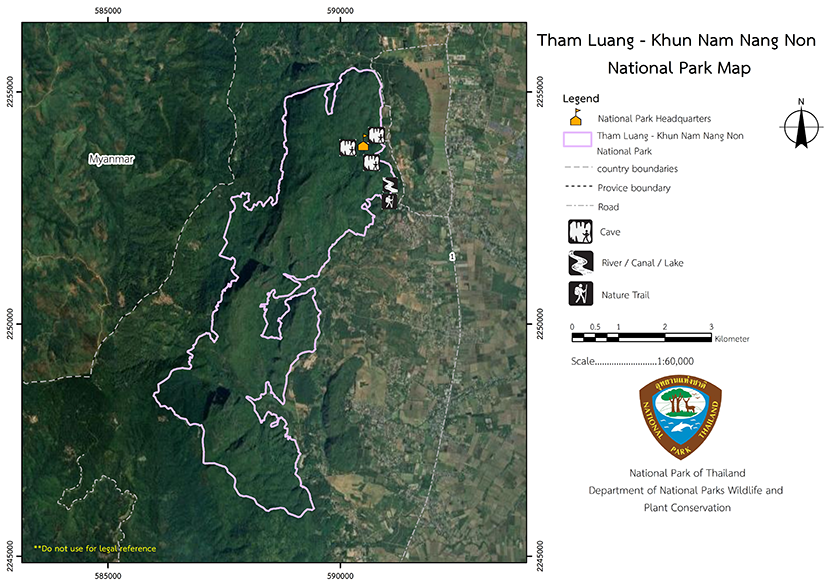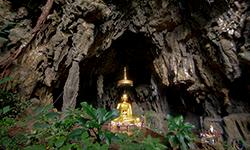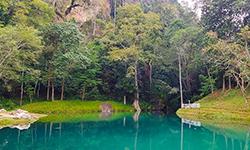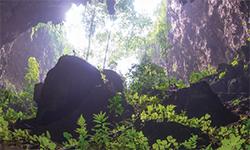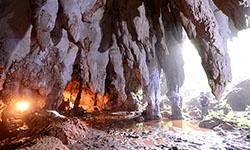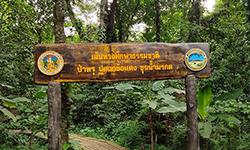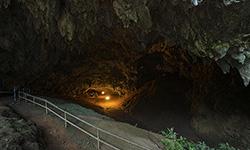Tham Luang-Khun Nam Nang Non National Park (under gazetting)
Contact Location : Baan Chong, Moo 9, Pong Pha Sub-district, Mae Sai District, Chiang Rai Province
Telephone Number : (+66) 9 4603 3511
Email : thamluang.nangnoncave@gmail.com
Facebook : Tham Luang-Khun Nam Nang Non National Park (under gazetting)
Note : After paying the entrance fee to the National Park, please carry the receipt for inspection.
12,000 rai (19.2 square kilometers)
|
|
|
|
|
|
|
|
|
Nature trails ⇔ Trekking ⇔ Cave exploration/Geological condition ⇔ Observe flowers/plant ⇔ Bird ⇔ Take a photo/Video
Welfare shop : Open daily from 8.30 – 16.30 hrs.
National Park Headquarters area : AIS, TRUE, DTAC
Khun Nam Nang Non-area : AIS, TRUE, DTAC
|
|
Tham Luang-Khun Nam Nang Non National Park (under gazetting) is a large karst topography comprised of numerous complexes on a north-south axis with a slight eastward slope. It is said to have the appearance of a sleeping woman and is also known as "Doi Nang Non" or "Doi Ya Thao." Slopes vary betweenapproximately 30 - 70 degrees, and exiss at an elevation of 300 -1,410 meters above sea level. Numerous creeks originate here, including Nam Dun Creek, Mueang Dong Creek, and Pak Tin Fai Creek.
|
|
The climate is a tropical monsoon. During the rainy season, it is influenced by the southeast monsoon, while in the winter, it is influenced by the northeast monsoon. Each year, the average minimum temperature is 7 degrees Celsius with a high maximum temperature of over 40degrees Celsius. Annual rainfall averages approximately 1,985 mm. Three seasons exist:
|
|
|
|
The Forest Resources: Mixed deciduous forests are distributed along the hillside from 300 to 900 meters in elevation. Visitors will observe trees from of 28 families, 53 genera, and 82 species with distinctive plant characteristics, including those of Caesalpiniaceae, Mimosaceae, Combretaceae, Lythraceae, Meliaceae, and Anacardiaceae, such as Macaomong (Afzelia xylocarp Roxb.), Large Crescent (Bauhinia malabarica Roxb.), Dangling (Dialium concninchinensis Pierre), Albizia odoratisisima Benth, Black Pantheon (Dalbergia cultural Grah. ex Bent) Red Chipotle (Dalbergia dongnaiensis Pierre) Padauk (Pterocarpus macrocarpus Kurz), Syndrome (Terminalia bellarica Roxb.), Blood Crustacean (Terminalia defeuillana Pierre ex Laness.), Big Tabby (Lagerstroemia. calyculata Kurz), Inthanin (Lagarstroemia speciosa Pers.), Inthanon Bok (Lagerstroemia macrocarpa Wall), Croton oblongifolius Roxb., Macaranga gigantean Muell, Toona ciliate Roem, Sore (Gmelina arborea Roxb.) Love White (Holigarna. longifolia Roxb.), and Sompong (Tetrameles nudiflora R.Br.). Bamboo is found in one family, four genera, and six species, mainly in dense pockets in the majority of trench areas. It includes wild bamboo (Bambusa arundinacea Wild.), Bamboo Bong (Bambusa natnas Wall.), and Bamboo. 6 (Dendrocalamus hamiltonii Nees & Arn.) Shrubs are abundant in areas with a higher concentration of miniature bamboo. There are 11 families, 14 genera, and 28 species, of shrubs including Wild Crescent (Bauhinia saccocalyx Pierre), Wild Indigofera (Indigofera sootepensis Craib), Homonoia riparia Lour., and Clawed Nails (Zizyphus oenoplia Mill.) On trees, vines and plants thrive. The area is densely forested with fern species. Nine families, 22 genera, and 28 species of herbaceous plants were discovered during the survey, including Eupatorium odoratum Linn. Bamboo Leaf Grass can be classified as Acroceras munroanum (Balansa) Hene. Konjac (Amorphophallus campanulatus Bl.ex Decne). There are ten families of vines, 13 genera, 17 species, such as Linden (Bauhinia sanders Linn), Pueraria Mirifica (Millettia auriculata Bax.), Nacra Scales (Dischidia imbricata Warb.), and nine families of clinging-to-dwelling plants, 17 genera, 61 species, for example, Staghorn Fern (Plytycerium coronarium Desv.), Giant Staghorn Fern (Platycerium grande J. Smith), Monkey's Paws (Lycopodium cernuum Linn.) The Hill Evergreen Forest begins at an elevation of 800 meters and is common on the high peaks. The survey identified 35 families, 48 genera, and 68 dominant species, including family Fagaceae, Theaceae, and Lauraceae Spur Formation (Castanopsis acuminatissima Rehd.), Bear (Lithocarpus auriculatus Barnett), Wild Hemp (Michelia floarbunda Finet & Gagnep.), Needle wood Tree (Schima wallichii Korth.), Cinnamon (Cinnamomum bejolghota Sweet), Tongle hen (Actinod Litsea semecarpifolia Hook. Ficus hispida Linn.f.) is a Milky (Ardisia vestita Fletch.) Tiger's Eye (Amoora polystachya Hook. f. & Jack). Shrubs discovered bear, which has resemblance to common woodwidely dispersed due to the dense canopy of the upper wood. 7 families, 12 genera, and 20 species are represented, including Wild Indigo (Indiagofera scotepensis Craib), Hom Chang (Viburnum cylindricum Ham. ex Don), and Chuknari (Melastoma normale D. Don). There are vines, perennial plants, and ferns, as well as cut flowers (Camchaya eberhardtii Gagnep), Thiandoi (Impatiens violiflora Hook.f.), Wild Pea (Clitoria macrophylla Wall.), and Ecumia (Dendrobium arachnites Reichb.f.).
Wildlife Resources: Nonetheless, 10 species are protected, including the Yellow Turtle (Indotestudo elongata), Orange-Winged Black-Speckled Chameleon (Dracunculus maculalus), Red-Headed Chameleon (Calotes versicolor), Forest crested lizard (Calotes emma), Water Monitor (Varanus salvator), Reticulated Python (Python reticular), Common Boa (Ptyas korros), and Ophiophagus hannah. The survey bird discovered 71 species in 35 families, 12 of which are endemic, and 61 species, 24 of which are extremely abundant, including the Tumix suscitator, Great Dove (Streptopelia chinensis), Long-Tailed Dove (Caprimulgus macrurus), and White-Breasted Kingfisher (Halcyon smyrnensis). The remaining 10 species are migratory and most prevalent during the winter, including the Black Bazaar (Aviceda leuphotes), Barn Swallows (Hirundo rustica) Red- rumped Swallows(Cecropis daurica), Dusky Warbler (Phylloseopus fuscatus), Yellow-Browed Warbler (Phylloscopus inornatus), Grey-Headed Bushchat (Saxicola ferrea), Red-Throated Flycatcher, (Ficedula parva) Shrike, Lanius cristatus, Olive-Backed Pipit (Anthus hodgsoni), Grey Wagtail (Motacilla cinerea), Black Hawks (Aviceda leuphotes), House Swallowtail (Hirundo rustica), and Dark-Colored Pelican (Phylloscopus fuscatus). There are six distinct species of winter visitors that are extremely numerous, which are the Brown Shrike, Barn Swallow, Red-Tailed Swallow, Dusky Warbler, Yellow-Browed Warbler, and Red-Throated Flycatcher. In terms of status, there are no birds in imminent danger and there are 59 species are protected wildlife, with 14 having a low population density, including the Black Baza,, Wildfowl (Gallus gallus), Woodpecker (Upupa epops), Northern Bulbul (Criniger pallidus), Dendrocitta vagabunda, Pellorneum ruficups, Trichastoma tickelli, White-Necked Wren (Abroscopus supercilliaris), House Magpie (Copsychus saularis), Garden Mole (Anthus hodgsni), Gray (Motacilla cinerea), Ruby-Cheeked Sunbird (Anthkeptes singalensis), Yellow-Bottomed Parasite (Dicaeum chrysorrtium), and Golden-Eyed White-Eyed Bird (Zosterops palpebrosus). Mammals are classified into 17 species, 10 families, and 5 ranks. There are nine species present, including the Common Chipmunk (Tupaia glis), Wild Rabbit (Lepus peguensis), Qquirrel (Callosciurus finlaysoni), Red-bellied Squirrel (Callosciurus flavimanus), Lumpur (Menetes berdmorei), large Voles (Bardicota indica), Roof Rat (Rattus rattus), Canomys badius, and some endangered species. There are 7 protected species, two of which are threatened: the Manis javarica and Felis chaus. |
How to get there by car :
- Chiang Rai - Mae Sai road along Asian Highway 1for about 3 kilometers. The road to the forest park is paved.
- How to get there by bus take the Mae Sai Line - Chiang Rai from Mae Sai Bus Terminal. The bus will travel down Asian Highway 1 , stopping at the Ariya Sound Shop. From there, take a motorbike to Soi Ban Chong Soi 7, and follow the road to Mu Ban Chong until you reach the Tham Luang-Khun Nam Nang Non National Park.
- Non Agency
- Non Reserve

